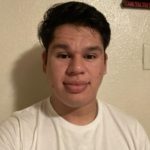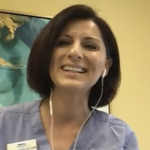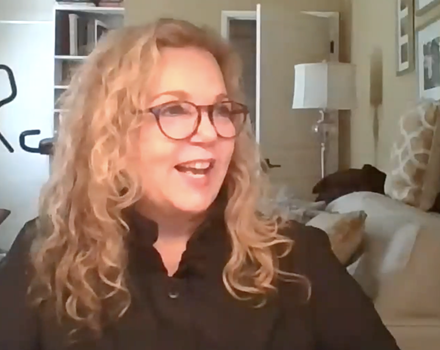At iMasons, our mantra is: “Connect. Grow. Give Back.” It encapsulates our mission to bring together members of the IT and datacenter community to connect and grow careers — but also to give our members a chance to give back to the communities they serve. Our new philanthropic organization, the Digital Infrastructure Futures Foundation (DIFF) focuses on this last piece: the “give back” aspect, in two main ways: One, by providing scholarships – in particular to promote diversity and inclusion in the data center and IT industry; and second, through a focus on tackling the digital divide, or what more recently had been referred to as “digital inclusion.” All aspects of this mission came into play in our latest endeavour: a Civic Learning experience for students at Cal State LA in East Los Angeles. Cal State LA is a designated Hispanic-serving institution; students are 58% women and 70% Hispanic. Sixty percent of the students are the first generation in their families to go to college. Many of them come from lower income backgrounds, and have themselves been impacted by the digital divide — lacking either wifi or devices at home to connect to it.
While many of us take for granted our laptops or smartphones and broadband connectivity, others in the U.S. are suffering from a lack of those things. During the Covid pandemic, a lack of connectivity, combined by widespread lockdowns and work and school from home brought the digital divide into stark relief. As it turns out, many Covid services — from governmental relief checks to vaccine appointments or Covid testing — must be made online. For particularly vulnerable populations — front line restaurant, health care and service workers, the elderly: not having access to either the devices, wifi, or the skills to navigate the myriad confusing governmental, pharmacy, public health and other websites can be overwhelming, adding stress to an already stressful situation. While we knew there was a digital divide in this country, the pandemic amplified the issues which were perhaps someone obscured pre-Covid. For example: kids who didn’t have wifi at home or devices could “get by” at school. But now, during this covid moment, many experienced a myriad of problems, from having too many people in the house trying to Zoom in to work or school, to not enough bandwidth, to having challenges — particularly as a young child — learning to manage Zoom: In some school districts, up to half of students never “reported for duty” at all in their classes. When school went online, they simply disappeared.
Senior citizens are another story altogether. They have been the group hardest hit by Covid, and are the ones the most vulnerable to health issues — both mental and physical. Those in senior care homes have been locked away from beloved family members, unable to take visitors due to Covid. While protecting them in some ways, this isolation has led to a decline in mental health, and increases in stress, loneliness and depression. All of these can lead to a decline in physical health or even the will to live. I will never forget one of the student videos that highlighted senior’s struggles: Standing outside a clinic on a busy street in Downtown Los Angeles, a tiny, vulnerable-looking elderly Latina woman’s eyes welled up with tears.

Speaking in soft Spanish behind a cloth mask, she said that her doctor’s office was only taking appointments on the Internet due to Covid, and she wasn’t able to get her medicine. What was already a vulnerable population — low income, elderly, and at-risk for Covid — now faced an unseen uphill battle just to get by.
This Is just one of many of the “Faces of the Digital Divide” we uncovered during this project.
But let me backup and describe for you what we did:
I was given the opportunity to develop a Civic Learning experience for the students at Cal State Los Angeles which would focus on the digital divide, in partnership with Infrastructure Masons and DIFF. The idea was to have students develop team projects which would tackle various aspects of the digital divide in their local communities. Cal State Los Angeles is located in East LA, an area hit particularly hard by the digital divide: studies show that only 53% of residents there have broadband, compared with 89% in West Los Angeles and South San Fernando Valley. At the same time, given that only 4% of the STEM workforce are women of color, this seemed the perfect opportunity to also expose a large number of college students — most of them Latinas — to the data center and IT industry, to perhaps encourage them or their family members or friends to work in the industry, while allowing our iMasons members to give back to this community.
We started out at a high level understanding of the digital divide, but through the course of time, all of us were able to develop a much more nuanced picture of the issues and problems particular to specific communities: Student-generated projects ranged from creating an awareness campaign around the needs of the Homeless in L.A., to teaching digital skills through storyboards for elementary and special needs kids needing to learn Zoom, to raising money for low income families and a foster care home, so the kids could have their own Amazon Fire tablets, to arranging for the purchase of tablet devices for a senior citizen home, and training the seniors how to power them on, charge them, and access apps for medical information, gaming, and most importantly — to connect with their families and loved ones.
Meet The Students
The students at Cal State LA come from a variety of backgrounds — they are diverse, hard-working, and want to make a difference in their communities. I saw many opportunities for them to go beyond simply applying time and effort to this problem: This was also an opportunity to mentor them and grow their skills as young leaders, to introduce them to the data center industry, and perhaps — to develop the next generation workforce. From ideation to implementation, project management, teamwork — to final presentation — many of the skills learned through this hands-on service learning project are directly applicable to their future as young leaders.
Here are three of the students we worked with this term:
Elena Song
 Elena really stood out as someone who has real leadership potential. As someone who has experienced housing insecurity first hand, Elena chose to do a project to address the digital divide amongst the homeless in LA County. She focused her team’s efforts on an education and outreach campaign, to educate political leadership in Glendale, California (a suburb of Los Angeles) about the digital divide and the needs of the homeless. As they discovered, many governmental Covid interventions, from applying to stimulus checks from the IRS, to signing up for a Covid vaccine — required an Internet connection to access. Elena had thought that homeless people would need devices. Much to her surprise, many already had them: Devices weren’t the problem — the issue was wifi. So her and her team shifted their efforts to an awareness campaign for local city officials and homeless organization executives, to educate them on the actual needs of this population. They contacted local libraries to see what programs were being offered, and if it would be possible to expand their wifi offering to the homeless. Her experience in the course impacted potentially not only the homeless – but her own sense of herself as someone who can make an impact:
Elena really stood out as someone who has real leadership potential. As someone who has experienced housing insecurity first hand, Elena chose to do a project to address the digital divide amongst the homeless in LA County. She focused her team’s efforts on an education and outreach campaign, to educate political leadership in Glendale, California (a suburb of Los Angeles) about the digital divide and the needs of the homeless. As they discovered, many governmental Covid interventions, from applying to stimulus checks from the IRS, to signing up for a Covid vaccine — required an Internet connection to access. Elena had thought that homeless people would need devices. Much to her surprise, many already had them: Devices weren’t the problem — the issue was wifi. So her and her team shifted their efforts to an awareness campaign for local city officials and homeless organization executives, to educate them on the actual needs of this population. They contacted local libraries to see what programs were being offered, and if it would be possible to expand their wifi offering to the homeless. Her experience in the course impacted potentially not only the homeless – but her own sense of herself as someone who can make an impact:
I didn’t know what to expect at all—not from what learning about the digital divide entailed, nor what civic learning even was. But to have created a project detailing the issue of Internet inaccessibility among the homeless population, and one that I was proud of at that, changed a lot of how I viewed the impact I could have on the world around me.
Jesus Hernandez
 Jesus and his team focused on high school kids in underserved areas of Los Angeles. The group went back to their high schools, including John C. Fremont HIgh school — a low income, predominately African American and Latino school; Belmont High School in Los Angeles — situated in a neighborhood with high rates of gang activity, poverty, and violence. The students surveyed 10th and 11th grade students, and found that computer literacy was low for things like Microsoft Office (e.g., Word, Power Point, Excel) and other programs needed for online schooling, including Xoom, Skype, and Google Duo. The students identified the problem that — these particular learning communities were not given access to basic computer literacy courses enjoyed by other students. They advocated that students at their alma mater schools be granted access to courses which would bring them up to speed, in terms of the skills-gap aspect of the digital divide. The outcome was that the administrators met, and decided that the counselors could allow students from outside the “traditional” learning communities to have computer literacy as a class. The students were very proud to have stepped up, researched the problem, presented it to the school administration — and they made a real difference.
Jesus and his team focused on high school kids in underserved areas of Los Angeles. The group went back to their high schools, including John C. Fremont HIgh school — a low income, predominately African American and Latino school; Belmont High School in Los Angeles — situated in a neighborhood with high rates of gang activity, poverty, and violence. The students surveyed 10th and 11th grade students, and found that computer literacy was low for things like Microsoft Office (e.g., Word, Power Point, Excel) and other programs needed for online schooling, including Xoom, Skype, and Google Duo. The students identified the problem that — these particular learning communities were not given access to basic computer literacy courses enjoyed by other students. They advocated that students at their alma mater schools be granted access to courses which would bring them up to speed, in terms of the skills-gap aspect of the digital divide. The outcome was that the administrators met, and decided that the counselors could allow students from outside the “traditional” learning communities to have computer literacy as a class. The students were very proud to have stepped up, researched the problem, presented it to the school administration — and they made a real difference.
Jesus said about his experience:
I have lived in South Central Los Angeles all my life, and will be the first to ever go to college in my family. Through, Community Coalition, I got to learn about the many social injustices that happen in my neighborhood, as well as how we are lacking resources and investment into the young lives that live here. It made me want to look for ways that I can positively impact the community. I first chose to take the class because it was necessary for the degree that I want to receive. I learned more than what I thought I would in this class. It was very educational to learn how the digital divide could be more than just not having internet and devices but also knowing how to use the Internet and its programs. By having students from different schools answer surveys we found out that many of them did not know how to operate programs like powerpoint, excel spreadsheets, or even send a “professional” email. Many of these students that come from schools like mine are from poor neighborhoods and don’t have the privilege of having classes where they can use computers for programing, animation, or computer literacy and it puts them at a disadvantage compared to kids who go to school in wealthier neighborhoods that get more investments and are offered partnerships with companies. How could students from low income areas possibly compete in a world where technology is advancing every single day?
Jesus and his team advocated for computer literacy courses to be offered to students in these less affluent high schools. After some discussion, the administration agreed to allow these students access to the courses. Jesus and his team’s efforts are bound to have a major impact in the lives of these kids and their lives.
Crystal Gomez
 Crystal is a graduating senior who chose to help senior citizens bridge the digital divide. Her and her team helped Margarita Kerchechian, the senior home administrator — choose and purchase tablet devices for the seniors. Crystal and her team then went to the senior home and trained them on how to charge them, turn them on, and use them. Reflecting on her experience, Crystal said:
Crystal is a graduating senior who chose to help senior citizens bridge the digital divide. Her and her team helped Margarita Kerchechian, the senior home administrator — choose and purchase tablet devices for the seniors. Crystal and her team then went to the senior home and trained them on how to charge them, turn them on, and use them. Reflecting on her experience, Crystal said:
From my personal experience, I grew up struggling financially but my mother worked extremely hard to get us the technology we needed for school such as a computer and WIFI. As a student who had once been affected by the Digital Divide, I understand the struggle of being a student with lack of technology resources. After hearing Margarita’s presentation and information on the Digital Divide with seniors, my group and I knew how important it was for us to get involved with the seniors. While working with this issue, we realized how much worse it got due to the current pandemic of Covid-19. Many seniors were forced to social distance from family and the world due to them being the most vulnerable to the Coronavirus. We learned about the effect of the lack of communication such as becoming lonely, depressed, lack of necessities and so much more. Therefore, we made an awareness video to show how important it is to teach seniors about technology. Having a smartphone can help seniors Facetime their families, shop online for necessities, make online doctor’s appointments, medical prescriptions, entertainment, social media, and more. Seniors mentioned how they wanted to learn about technology because society is moving into a technologically advanced world and therefore, they don’t want to be stuck in a hole and left behind. The highlight about this experience for myself was learning that seniors want to learn if they are taught. They haven’t given up, and with the help of the community and classes such as Civic Learning, we are slowly making a great difference.
Ms. Margarita Kerchechian opened the Ararat Senior Home in Glendale, California to Crystal and other students, to work with her seniors there.
 She guest lectured on Seniors and the Digital Divide — including their lack of skills and problems with devices, like the buttons being close together, or the devices not able to be turned up loud enough in some cases. She supervised a number of student projects, agreed to buy devices for her senior residents, and allowed the students to come in and train the seniors. One group met a woman there who had had multiple strokes and wasn’t able to communicate. Somehow, the students figured out she liked playing games and music — so they taught her how to use a poker app and play music on a tablet device. It opened up an entire new world of activities for her to do day to day. Margarita Kerchechian, the senior home administrator, had this to say:
She guest lectured on Seniors and the Digital Divide — including their lack of skills and problems with devices, like the buttons being close together, or the devices not able to be turned up loud enough in some cases. She supervised a number of student projects, agreed to buy devices for her senior residents, and allowed the students to come in and train the seniors. One group met a woman there who had had multiple strokes and wasn’t able to communicate. Somehow, the students figured out she liked playing games and music — so they taught her how to use a poker app and play music on a tablet device. It opened up an entire new world of activities for her to do day to day. Margarita Kerchechian, the senior home administrator, had this to say:
Your students were passionate about helping our residents during their visits and we enjoyed having them! Watching people’s faces light up during these visits was priceless. It meant so much to them that someone would take the time to thoroughly explain these very complex devices, especially when their own kids and grandkids are usually too busy to do it. Many are still asking when the kids will be back.
Seeing the joy and surprise in the faces of the seniors — as they saw the faces of their loved light up on a screen that they’d been separated from for so long during Covid was an absolute joy.

After the project was completed, Ms. Kerchechian said:
Your students’ visits helped not only individuals- who had an entire world suddenly open up to them, but the organization as a whole, as we are now making more of an effort to connect our residents to technology. (We had an “Aha!” moment at the realization that our elders were more capable than we imagined in learning these new skills!) So, thank you. It was wonderful hosting your students. It felt normal and nice to have outside visitors and we missed that very much in the last year.
Some of the groups focused their efforts on other vulnerable populations, namely: Low Income Mothers and their kids, and Foster Kids. The Foster Kids group realized that these kids were already struggling with issues as young teens in foster care, often the result of parental neglect or abuse; having now to also struggle with trying to make it to school because they didn’t have devices added insult to injury. The students identified a particular foster home, and began a “Go Fund Me” campaign which they promoted on social media, to buy Amazon Fire tablets for the kids. These projects not only helped the recipients of their efforts — but they developed important leadership and project management skills in the students themselves, as they had to see a project through, from start to finish. As one student, Brisa, put it:
I actually learned to be a leader and the reason I say that is because I was able to communicate with the coordinator of the organization and take on important roles that I did not think to possibly take. From this experience I will continue to help others because that has always been something of interest. I definitely had such a great experience and want to continue to make an impact on people’s lives.
Finally, groups of students focused on another heavily impacted group during Covid: Kids trying to go to school, from elementary through college. The students didn’t have to look far for inspiration: Administrators at Cal State LA had already loaned out 1585 wifi hotspots, and 1051 laptops to students in need at the university. Groups of students spoke to local school teachers, to parents, and to school administrators locally, to get a better handle on the issue. What they found was overwhelmed teachers, parents who didn’t know how to work technology like Zoom themselves, and some underserved schools in low income communities perpetuating the digital divide by limiting which schools got access to computer training courses. One of the biggest surprised was that teachers themselves were struggling with devices and technology, themselves “left to their own devices” without training after being suddenly thrust into online teaching: One teacher, “Mrs. Guiterrez” said:
Biggest technological struggle is the weak outdated laptop. District set us up with a new doc reader, speakers, recorder for zoom etc however the classroom laptop is not powerful enough and we have to use it without a doc reader. We also spent a lot of our personal time setting up the smartboard and learning to use this since there was no training whatsoever.
Kindergartners now are expected to know how to use Zoom to go to school. I quickly realized how — we need a kid’s version of Zoom. How would a Kindergartner know for example what “Participants” or “Security” even mean? Some student groups created Storyboards to help both beleaguered parents who don’t know the technology themselves help their kids, for teachers, or to help the kids help themselves when Mom or Dad are trying to work from home. Still others raised awareness for computer training sessions at the local Boys and girls Club through creating flyers and getting the word out to local schools about these courses to bolster computer skills.
This course would not have been possible without the generous gift of time and experience of our IMasons volunteers. They took part in supporting this course from start to finish, by guest lecturing and judging the final projects. Ms. Nancy Novak of Compass Datacenters who is spearheading our Digital Divide effort now — consulted on the development of the course, and later guest lectured on the Digital Divide. Ms. Ivonne Valdes of Schneider Electric spoke about the Global Digital Divide — and about her career path in the industry.

Many of you in the industry may not realize the subtle impacts your very presence has on students like these when you give of your time. This story is but one example: at the end of the Civic Learning class, I had the students reflect on their experiences, and on what they learned about the digital divide — and what they’d be taking away from the experience as a young leader in their communities. After giving her reflection, one of the female students said, “Can I say something else?” “Of course!” I replied. Then she said something so touching:
I work with teens at a school here… Remember when you had — Ivonne Valdes come in to speak?
Me: From Schneider Electric, of course I do! She’s wonderful!
She then went on to say:
I showed my kids the video from our class. And — them just seeing her was so inspiring … They’re Latino, and so am I — to see someone who is so successful had such an impact. For the kids too — the fact that she’s a Latina, they were like — “Hey! There’s someone that looks like me!” So— I want to thank you, for bringing her to our class…
When we started this journey with the idea of a Civic Learning project focused on the digital divide, it seemed a daunting problem, like boiling the ocean. Yet as we talked about it, I thought: Isn’t it better to do something — even maybe if it’s small — than to do nothing at all?” This Spring was a trial run, and we weren’t sure what to expect. But the student projects turned out to be meaningful, impactful, and educational for us at iMasons, shedding light on the nuances of the digital divide, uncovering problems many of us hadn’t even considered. For their part, the students each received a small scholarship from Digital Infrastructure Futures Foundation (DIFF). For us at iMasons — we learned many lessons, and are honing a “course pack” of instructional worksheets and a syllabus — which could be provided to other schools as as kind of a “course in a box” — to amplify our efforts at other schools across the nation and possibly elsewhere. Many schools are requiring service learning for their students — the digital divide is simply one “focus” that most hadn’t even thought of addressing. The course also gave us the opportunity to introduce the students to the data center industry. As a diverse group of future workers — these students — or perhaps their peers, or brothers or sisters — may consider a career they’d never even heard of before.
In the end — students learned about the digital divide, and came up with creative solutions for how to solve it in their corner of the world. But perhaps as importantly — they learned something about themselves: as citizens, and as emerging leaders. Executive Director Jeff Omelchuck wrapped up the course, by saying:
“You learned something about yourself and something about Society: there is this thing, this Digital Divide, and you do have the capability to to help people, even if it’s one at a time across the digital divide — and in some cases, you may be setting up programs that help lots of people… and you are capable of doing that. You can change society and that was one of the learnings, I think, in this class. It was really exciting to see some of you sort of — start to recognize it in yourself that “I can do this” and you can make a difference, so it was really fun seeing you begin to make that realization, and find that in yourself.”
The thinking around the digital divide is beginning to evolve — towards thinking about it as “digital inclusion.” The notion of digital inclusion addresses issues of opportunity, access, knowledge, and skill at the level of policy.[1] To work toward digital inclusion, this Fall, we will be doing another round of these student-led projects. This time though, we will also be partnering with Mr. Eduardo Velasco and his company WaveMax. They are installing 5G infrastructure in bodegas, beginning in New York City to provide Internet connectivity to the underserved. He has also partnered with a fintech company to provide financial services for the unbanked, to pay bills, or to send money back — “remittances” — home to family members. Our students will help to expand their reach in the East Los Angeles and Greater Los Angeles region by identifying bodegas and other locations for their 5G wifi, which is offered free to customers of the shops. We’re very excited about the possibilities of continuing to address the digital divide from a grass-roots level, and amplifying our efforts in the Fall.
Big thanks to everyone who participated and supported this course, including: Nancy Novak, Ivonne Valdes, Carrie Goetz, Margarita Kerchechian, Erin Heekin, Bill Kleyman, and Jeff Omelchuck. Everyone had a great time working with these students and hearing about the great work they’re doing in their communities. Feel free to reach out if you’d like to participate in future courses with us!
[1] What is Digital Inclusion? What is Digital Inclusion? | Digital Inclusion Survey 2013. (n.d.). https://digitalinclusion.umd.edu/content/what-digital-inclusion?fbclid=IwAR0Pdx_cvciElY777yWIA5a9BYv-hHj4g7jdHeIecSrRsV8H4nh4fjAXcsA.

